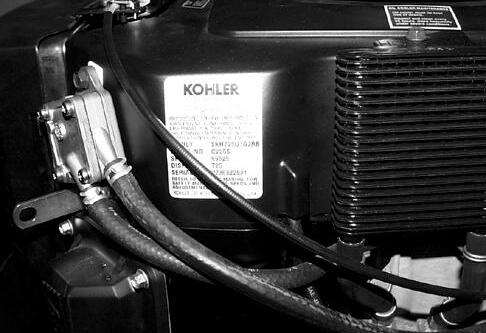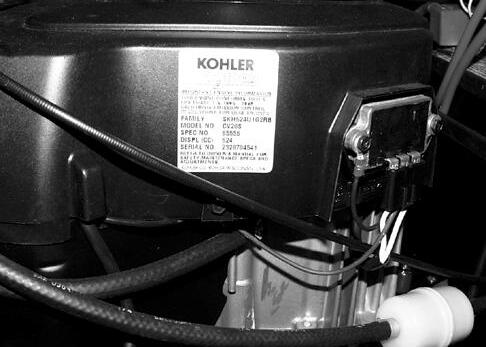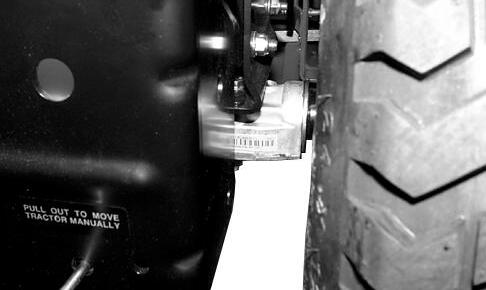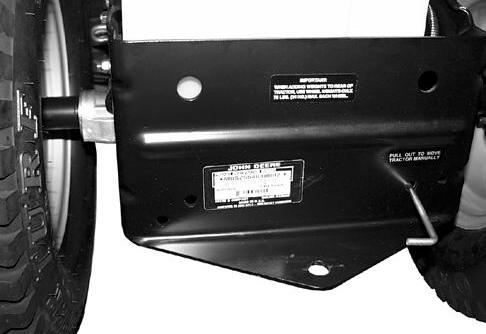
11 minute read
BATTERIES
from JOHN DEERE S2554 SCOTTS YARD AND GARDEN TRACTOR Service Repair Manual Instant Download
by kmd9iso9dkk
Prevent Battery Explosions
• Keep sparks, lighted matches, and open flame away from the top of battery. Battery gas can explode.
Advertisement
• Never check battery charge by placing a metal object across the posts. Use a volt-meter or hydrometer.
• Do not charge a frozen battery; it may explode. Warm battery to 16°C (60°F).
Prevent Acid Burns
• Sulfuric acid in battery electrolyte is poisonous. It is strong enough to burn skin, eat holes in clothing, and cause blindness if splashed into eyes.
• Avoid acid burns by:
1. Filling batteries in a well-ventilated area.
2. Wearing eye protection and rubber gloves.
3. Avoiding breathing fumes when electrolyte is added.
4. Avoiding spilling or dripping electrolyte.
5. Use proper jump start procedure.
• If you spill acid on yourself:
1. Flush your skin with water.
2. Apply baking soda or lime to help neutralize the acid.
3. Flush your eyes with water for 10_15 minutes.
4. Get medical attention immediately.
• If acid is swallowed:
1. Drink large amounts of water or milk.
2. Then drink milk of magnesia, beaten eggs, or vegetable oil.
3. Get medical attention immediately.
Use Safe Service Procedures
Wear Protective Clothing
Wear close fitting clothing and safety equipment appropriate to the job.
Prolonged exposure to loud noise can cause impairment or loss of hearing. Wear a suitable hearing protective device such as earmuffs or earplugs to protect against objectionable or uncomfortable loud noises.
Operating equipment safely requires the full attention of the operator. Do not wear radio or music headphones while operating machine.
Service Machines Safely
Tie long hair behind your head. Do not wear a necktie, scarf, loose clothing, or necklace when you work near machine tools or moving parts. If these items were to get caught, severe injury could result.
Remove rings and other jewelry to prevent electrical shorts and entanglement in moving parts.
Use Proper Tools
Use tools appropriate to the work. Makeshift tools and procedures can create safety hazards. Use power tools only to loosen threaded parts and fasteners. For loosening and tightening hardware, use the correct size tools. DO NOT use U.S. measurement tools on metric fasteners. Avoid bodily injury caused by slipping wrenches. Use only service parts meeting John Deere specifications.
Park Machine Safely
Using High Pressure Washers
Directing pressurized water at electronic/electrical components or connectors, bearings, hydraulic seals, fuel injection pumps or other sensitive parts and components may cause product malfunctions. Reduce pressure and spray at a 45 to 90 degree angle.
Illuminate Work Area Safely
Illuminate your work area adequately but safely. Use a portable safety light for working inside or under the machine. Make sure the bulb is enclosed by a wire cage. The hot filament of an accidentally broken bulb can ignite spilled fuel or oil.
Before working on the machine:
1. Lower all equipment to the ground.
2. Stop the engine and remove the key.
3. Disconnect the battery ground strap.
4. Hang a “DO NOT OPERATE” tag in operator station.
Support Machine Properly And Use Proper Lifting Equipment
Work In Ventilated Area
If you must work on a lifted machine or attachment, securely support the machine or attachment.
Do not support the machine on cinder blocks, hollow tiles, or props that may crumble under continuous load. Do not work under a machine that is supported solely by a jack. Follow recommended procedures in this manual.
Lifting heavy components incorrectly can cause severe injury or machine damage. Follow recommended procedure for removal and installation of components in the manual.
Work In Clean Area
Before starting a job:
1. Clean work area and machine.
2. Make sure you have all necessary tools to do your job.
3. Have the right parts on hand.
4. Read all instructions thoroughly; do not attempt shortcuts.
Engine exhaust fumes can cause sickness or death. If it is necessary to run an engine in an enclosed area, remove the exhaust fumes from the area with an exhaust pipe extension.
If you do not have an exhaust pipe extension, open the doors and get outside air into the area.
WARNING: California Proposition 65
Warning:
Diesel engine exhaust and some of its constituents are known to the State of California to cause cancer, birth defects, and other reproductive harm.
Gasoline engine exhaust from this product contains chemicals known to the State of California to cause cancer, birth defects, or other reproductive harm.
Remove Paint Before Welding Or Heating
Avoid potentially toxic fumes and dust. Hazardous fumes can be generated when paint is heated by welding, soldering, or using a torch. Do all work outside or in a well ventilated area. Dispose of paint and solvent properly. Remove paint before welding or heating: If you sand or grind paint, avoid breathing the dust. Wear an approved respirator. If you use solvent or paint stripper, remove stripper with soap and water before welding. Remove solvent or paint stripper containers and other flammable material from area. Allow fumes to disperse at least 15 minutes before welding or heating.
Avoid Harmful Asbestos Dust
Avoid breathing dust that may be generated when handling components containing asbestos fibers. Inhaled asbestos fibers may cause lung cancer. Components in products that may contain asbestos fibers are brake pads, brake band and lining assemblies, clutch plates, and some gaskets. The asbestos used in these components is usually found in a resin or sealed in some way. Normal handling is not hazardous as long as airborne dust containing asbestos is not generated.
Avoid creating dust. Never use compressed air for cleaning. Avoid brushing or grinding material containing asbestos. When servicing, wear an approved respirator. A special vacuum cleaner is recommended to clean asbestos. If not available, apply a mist of oil or water on the material containing asbestos. Keep bystanders away from the area.
Service Tires Safely
AVOID INJURY FROM ROTATING BLADES, AUGERS AND PTO SHAFTS
Explosive separation of a tire and rim parts can cause serious injury or death.
Do not attempt to mount a tire unless you have the proper equipment and experience to perform the job. Always maintain the correct tire pressure. Do not inflate the tires above the recommended pressure. Never weld or heat a wheel and tire assembly. The heat can cause an increase in air pressure resulting in a tire explosion. Welding can structurally weaken or deform the wheel.
When inflating tires, use a clip-on chuck and extension hose long enough to allow you to stand to one side and NOT in front of or over the tire assembly. Use a safety cage if available.
Check wheels for low pressure, cuts, bubbles, damaged rims or missing lug bolts and nuts.
Keep hands and feet away while machine is running. Shut off power to service, lubricate or remove mower blades, augers or PTO shafts.
Handle Chemical Products Safely
Direct exposure to hazardous chemicals can cause serious injury. Potentially hazardous chemicals used with John Deere equipment include such items as lubricants, coolants, paints, and adhesives.
A Material Safety Data Sheet (MSDS) provides specific details on chemical products: physical and health hazards, safety procedures, and emergency response techniques. Check the MSDS before you start any job using a hazardous chemical. That way you will know exactly what the risks are and how to do the job safely. Then follow procedures and recommended equipment.
Dispose of Waste Properly
Improperly disposing of waste can threaten the environment and ecology. Potentially harmful waste used with John Deere equipment include such items as oil, fuel, coolant, brake fluid, filters, and batteries. Use leakproof containers when draining fluids. Do not use food or beverage containers that may mislead someone into drinking from them. Do not pour waste onto the ground, down a drain, or into any water source. Inquire on the proper way to recycle or dispose of waste from your local environmental or recycling center, or from your John Deere dealer.
Live With Safety
Before returning machine to customer, make sure machine is functioning properly, especially the safety systems. Install all guards and shields.
Specifications
ENGINE (2554)
TRANSAXLE (HYDROSTATIC)
TIRES
MOWER DECK (48-INCH)
MOWER DECK (54-INCH)
Inch Torque Values
DO NOT use these values if a different torque value or tightening procedure is given for a specific application. Torque values listed are for general use only. Check tightness of fasteners periodically.
Shear bolts are designed to fail under predetermined loads. Always replace shear bolts with identical grade. Fasteners should be replaced with the same or higher grade. If higher grade fasteners are used, these should only be tightened to the strength of the original.
Make sure fasteners threads are clean and that you properly start thread engagement. This will prevent them from failing when tightening.
Tighten plastic insert or crimped steel-type lock nuts to approximately 50 percent of the dry torque shown in the chart, applied to the nut, not to the bolt head.
Tighten toothed or serrated-type lock nuts to the full torque value.
a “Lubricated” means coated with a lubricant such as engine oil, or fasteners with phosphate and oil coatings. “Dry” means plain or zinc plated without any lubrication.
b Grade 2 applies for hex cap screws (not hex bolts) up to 152 mm (6 in.) long. Grade 1 applies for hex cap screws over 152 mm (6 in.) long, and for all other types of bolts and screws of any length.
Metric Torque Values
DO NOT use these values if a different torque value or tightening procedure is given for a specific application. Torque values listed are for general use only. Check tightness of fasteners periodically.
Shear bolts are designed to fail under predetermined loads. Always replace shear bolts with identical property class.
Fasteners should be replaced with the same or higher property class. If higher property class fasteners are used, these should only be tightened to the strength of the original.
Make sure fasteners threads are clean and that you properly start thread engagement. This will prevent them from failing when tightening.
Tighten plastic insert or crimped steel-type lock nuts to approximately 50 percent of the dry torque shown in the chart, applied to the nut, not to the bolt head. Tighten toothed or serrated-type lock nuts to the full torque value. a “Lubricated” means coated with a lubricant such as engine oil, or fasteners with phosphate and oil coatings.
“Dry” means plain or zinc plated without any lubrication.
Gasoline Specifications
Caution
Handle fuel with care, it is highly flammable. DO NOT refuel machine:
• Indoors. Always fill fuel tank outdoors.
• While you smoke.
• When machine is near and open flame or sparks.
• When engine is running. STOP engine.
• When engine is hot. Allow it to cool.
Help prevent fires:
• Fill fuel tank only to bottom of filler neck.
• Clean oil, grease and dirt from machine.
• Clean up spilled fuel immediately.
• Do not store machine with fuel in tank in a building where fumes may reach an open flame or spark.
To prevent fire and explosion caused by static electric discharge while you fill tank:
• Use approved, non-metal fuel container.
• When using a funnel, MAKE SURE it is PLASTIC.
• Avoid using a funnel which has a metal screen or filter.
IMPORTANT: To avoid engine damage:
• DO NOT mix oil with gasoline
• Use only clean oil and fuel
• Use clean approved containers and funnels.
• Store oil and fuel in an area protected from dust, moisture and other contamination.
Unleaded fuel is recommended because it burns cleaner and leaves less unburned deposits in engine combustion chamber. Regular unleaded gasoline with an anti-knock index of 85 octane or higher may be used. Use of gasohol is acceptable as long as the ethyl alcohol blend does not exceed 11 percent. Do not use gasoline that contains Methanol.
Fill fuel tank at end of each day's operation. Fill only to bottom of filler neck.
Gasoline Storage
Keep fuel in a clean container in a protected area. Do not use deicers to remove water from fuel. Do not depend on fuel filters to remove water.
If possible, install a water separator at the storage tank outlet.
IMPORTANT: Keep all dirt, scale, water or other foreign material out of fuel.
If mower is stored for the winter, add gasoline storage stabilizer to the fuel. Follow directions on can.
Lubricant Specifications
Engine Oil
Use oil viscosity based on the expected air temperature range during the period between oil changes.
The following oil is preferred:
• 10W30
Other oils may be used if they meet one of the following:
• API Service Classification SG
• API Service Classification SF
• CCMC Specification G4
Oils meeting Military Specification MIL-L-46167B may be used as arctic oils.
ENGINE BREAK–IN OIL
IMPORTANT: ONLY use a quality break-in oil in rebuilt or remanufactured engines for the first 5 hours (maximum) of operation. DO NOT use oils with heavier viscosity weights than SAE 5W-30 or oils meeting specifications API SG, SH; or oils meeting CCMC Specification G5. These oils will not allow rebuilt or remanufactured engines to break-in properly.
Hydrostatic Transmission Oil
Use the appropriate oil viscosity based on these air temperature ranges. Operating outside of these recommended oil air temperature ranges may cause premature hydrostatic transmission failure.
IMPORTANT: ONLY use a quality SAE 5W-30 (2048) or 5W-50 SYNTHETIC (2554) engine oil in this transmission. Mixing of two viscosity grade oils is NOT RECOMMENED. DO NOT use BIO–HY–GARD® in this transmission.
The following oil is RECOMMENDED:
• S2048 use 5W-30 or 10W-30
• S2554 use 5W-50 SYNTHETIC
Use only oils that meet the following specifications:
• API Service Classifications SG or higher.
• CCMC Specifications G4 or higher.
Grease
Use grease based on the expected air temperature range during the service interval. The following greases are preferred:
• MOLY HIGH TEMPERATURE EP GREASE
• HIGH TEMPERATURE EP GREASE
• MULTI-PURPOSE GREASE
John Deere Dealers: You may want to cross-reference the following publications to recommend the proper oil for your customers:
• Module DX,ENOIL2 in JDS–G135;
• Section 530, Lubricants & Hydraulics, of the John Deere Merchandise Sales Guide;
• Lubrication Sales Manual PI7032.
Other greases may be used if they meet one of the following:
• SAE Multipurpose EP Grease with a maximum of 5% molybdenum disulfide.
• SAE Multipurpose EP Grease Greases meeting Military Specification MIL-G-10924F may be used as arctic grease.
Alternative Lubricants
Conditions in certain geographical areas outside the United States and Canada may require different lubricant recommendations than these printed in this manual or the operator's manual. Consult with your John Deere Dealer, or Sales Branch to obtain the alternative lubricant recommendations.
Synthetic Lubricants
Synthetic lubricants may be used in equipment if they meet the applicable performance requirements (industry classification and/or military specification) as shown in this group.
The recommended temperature limits and service or oil change intervals should be maintained as shown in the operator’s manual.
Avoid mixing different brands, grades, or types of oil. Oil manufacturers blend additive in their oils to meet certain specifications and performance requirements. Mixing different oils can interfere with the proper functioning of these additives and degrade lubricant performance.
Oil Filters
Filtration of oils is critical to proper lubrication. Always change filters regularly.
Use filters meeting John Deere performance specification.

Lubricant Storage
This machine can operate at top efficiency only if clean lubricants are used.
Use clean containers to handle all lubricants. Store them in an area protected from dust, moisture, and other contamination. Store drums on their sides.
Serial Number Locations
When working on machines or components that are covered by warranty, it is IMPORTANT that you include the tractor identification number and the component serial numbers on the warranty claim form.

The location of tractor identification number and component serial numbers are shown below.
Tractor Identification

Specifications
1. NOTE: Specifications are for all engines unless otherwise noted.
TEST & ADJUSTMENT SPECIFICATIONS
Repair Specifications
Torque Specifications
Suggest:
If the above button click is invalid.
Please download this document first, and then click the above link to download the complete manual.
Thank you so much for reading


